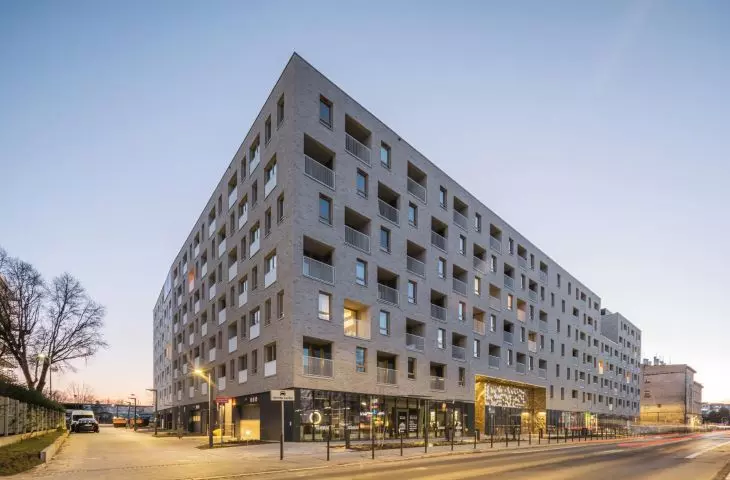Article from A&B issue 05|2023
How to shape good residential architecture?
Residential architecture, which happens to be an area of numerous interesting explorations and formal and aesthetic experiments in Europe, in Poland unfortunately seems more inclined to maintain conventional and repetitive solutions. It also tends to be simply boring and sometimes ugly. What are the reasons for this state of affairs? Economic and formal considerations, lack of will or courage on the part of investors, and even the lack of specific expectations of future residents lock most projects and developments within the framework of minimizing expenditures and maximizing saleable floor space. But is there really a shortage of people in Poland with clear expectations of their apartment and surroundings? How to shape good residential architecture despite limitations?
Braniborska 44-52 Wrocław | proj.: Arch_it Piotr Zybura
photo: Maciej Lulko © Arch_it Piotr Zybura
The basic features of residential architecture seem obvious. These include functionality, aesthetics, accessibility and affordability, which is particularly—or even exclusively—important for many buyers, while at the same time may limit design and implementation possibilities.
Braniborska 44-52 Wrocław | proj.: Arch_it Piotr Zybura
photo: Mateusz Olczyk © Arch_it Piotr Zybura
A successful multifamily residential building should foster a sense of community creation. Common spaces should be designed to encourage interaction and integration, and the building in such a way as to foster a sense of belonging and community. It is essential to have an appropriate balance of public, semi-public and private spaces, and to ensure accessibility to common spaces used by residents (for example, community centers). Consideration should be given to linkage with the surrounding area—both by taking into account urban, aesthetic and social contexts, as well as simply providing free passage and access for the public. In downtown developments, moreover, one should strive to create city-forming features of the development (ground-floor services, public squares) and green areas. Large glazing and multi-lighted apartments, providing adequate amounts of natural light positively affect the well-being of residents, especially when they allow direct contact with landscaped greenery.
Braniborska 44-52 Wrocław | design: Arch_it Piotr Zybura
photo: Mateusz Olczyk © Arch_it Piotr Zybura
European trends worth noting include:
- reductionism: aesthetic minimalism and environmentally responsible reduction of inputs and materials;
- housing flexibility: that is, shaping unit layouts in such a way that they can be easily adapted to the changing needs of residents;
- design with sustainability in mind by including energy-saving systems, the use of sustainable and ecological materials, intensive use of greenery;
- Innovative solutions for unusual ways of living (multi-generational housing, collective forms of housing, such as in the Hunziker Areal development in Zurich);
- design of community spaces (day care centers, workshops, gardens) and spaces for residents to work.
Braniborska 44-52 Wrocław | proj.: Arch_it Piotr Zybura
photo: Mateusz Olczyk © Arch_it Piotr Zybura
Good and innovative residential architecture has a chance to appear more widely, because the expectations of users are changing (although, unfortunately, their purchasing power is also decreasing!), as well as the awareness of designers and investors (slowly!). The development impulse should be—although unfortunately they are very rare—non-commercial ventures, such as social housing initiatives, micro-investment communities supported by adequate financing.
Braniborska 44-52 Wrocław | design: Arch_it Piotr Zybura
photo: Maciej Lulko © Arch_it Piotr Zybura
Piotr Zybura
arch_it piotr zybura architektura+design
In previous episodes of the series, the following have spoken:
- Robert Maciaszek—Mayor of Chrzanów since 2018. Lawyer and manager with many years of experience in business and local government.
- Piotr Sobociński— Sobociński Architekci, president of SARP Branch in Toruń
- Tomasz Grębski—Grębski design studio.
- Aleksandra Targońska—TZA
- Jakub and Jerzy Turbasa.
- Szymon Wojciechowski—APA Wojciechowski Architekci
- Wojciech Wyka, Marek Pawłowski—ART Architekci
- Anna Kalbarczyk—S. A.M.I. Architects


























